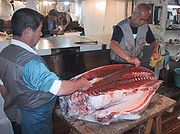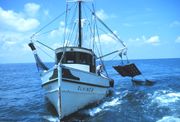Tsukiji fish market

The Tokyo Metropolitan Central Wholesale Market (東京都中央卸売市場 Tōkyō-to Chūō Oroshiuri Shijō), commonly known as the Tsukiji Market (築地市場 Tsukiji shijō), is the biggest wholesale fish and seafood market in the world and also one of the largest wholesale food markets of any kind. The market is located in Tsukiji in central Tokyo, and is a major attraction for foreign visitors.[1]
|
Location

The market is located near the Tsukijishijō Station on the Toei Ōedo Line and Tsukiji Station on the Tokyo Metro Hibiya Line. There are two distinct sections of the market as a whole. The "inner market" (jonai shijo) is the licensed wholesale market, where the auctions and most of the processing of the fish take place, and where licensed wholesale dealers (approximately 900 of them) operate small stalls. The "outer market" (jogai shijo) is a mixture of wholesale and retail shops that sell Japanese kitchen tools, restaurant supplies, groceries, and seafood, and many restaurants, especially sushi restaurants. Most of the shops in the outer market close by the early afternoon, and in the inner market even earlier.
Economics

The market handles more than 400 different types of seafood from tiny sardines to 300kg tuna, from cheap seaweed to the most expensive caviar. Overall, more than 700,000 metric tons of seafood are handled every year at the three seafood markets in Tokyo, with a total value in excess of 600 billion yen (approximately 5.5 billion US dollars). Tsukiji alone handles over 2000 metric tons of seafood per day. The number of registered employees varies from 60,000 to 65,000, including wholesalers, accountants, auctioneers, company officials, and distributors.
Operations


The market opens most mornings except Sundays and holidays and some infrequent closing days in the week[2] at 3:00 a.m. with the arrival of the products by ship, truck and plane from all over the world. Particularly impressive is the unloading of tons of frozen tuna. The auction houses (wholesalers known in Japanese as oroshi gyōsha) then estimate the value and prepare the incoming products for the auctions. The buyers (licensed to participate in the auctions) also inspect the fish to estimate which fish they would like to bid for and at which price.
The auctions start around 5:20 a.m. Bidding can only be done by licensed participants. These bidders include intermediate wholesalers (nakaoroshi gyōsha) who operate stalls in the marketplace and other licensed buyers who are agents for restaurants, food processing companies, and large retailers.
The auctions usually end around 7:00 a.m. Afterward, the purchased fish is either loaded onto trucks to be shipped to the next destination or on small carts and moved to the many shops inside the market. There the shop owners cut and prepare the products for retail. In case of large fish, for example tuna and swordfish, cutting and preparation is elaborate. Frozen tuna and swordfish are often cut with large band saws, and fresh tuna is carved with extremely long knives (some well over a meter in length) called oroshi hocho, maguro-bocho, or hancho hocho.
The market is the busiest between 5:30 and 8:00 a.m., and the activity declines significantly afterward. Many shops start to close around 11:00 a.m., and the market closes for cleaning around 1:00 p.m. Tourists may visit the market daily between 5 a.m. and 6:15 a.m. and watch the proceedings from a designated area[3], except during periods when it is closed to the public.
Because of an increase in sightseers and the associated problems they cause, the market had banned all tourists from the tuna auctions on several occasions, including from 15 December 2008 through 17 January 2009[4], 10 December 2009 through 23 January 2010[5], and 8 April 2010 through 10 May 2010.[6] After the latest ban that ended in May 2010, the tuna auctions have been re-opened to the public with a maximum limit of 140 visitors per day on a first-come, first-serve basis.[7] The market is closed on Sundays, holidays and some Wednesdays.
Inspectors from the Tokyo Metropolitan Government supervise activities in the market to enforce the Food Hygiene Law.
History

The first market in Tokyo was established by Tokugawa Ieyasu during the Edo period to provide food for Edo castle (nowadays Tokyo). Tokugawa Ieyasu invited fishermen from Tsukuda, Osaka to Edo to provide fish for the castle. Fish not bought by the castle was sold near the Nihonbashi bridge, at a market called uogashi (literally, "fish quay") which was one of many specialized wholesale markets that lined the canals of Edo (as Tokyo was known until the 1870s).
In August 1918, following the so-called "Rice Riots" (Kome Soudou), which broke out in over 100 cities and towns in protest against food shortages and the speculative practices of wholesalers, the Japanese government was forced to create new institutions for the distribution of foodstuffs, especially in urban areas. A Central Wholesale Market Law was established in March 1923.
The Great Kantō earthquake on September 1, 1923, devastated much of central Tokyo, including the Nihonbashi fish market. In the aftermath of the earthquake, the market was relocated to the Tsukiji district and, after the construction of a modern market facility was completed in 1935, the fish market began operations under the provisions of the 1923 Central Wholesale Market Law. Three major markets in Tsukiji, Kanda, and Koto began operating in 1935. Smaller branch markets were established in Ebara, Toshima, and Adachi, and elsewhere. At present, the Tokyo Metropolitan Government's system of wholesale markets includes more than a dozen major and branch markets, handling seafood, produce, meat, and cut flowers.
The Building
Following the Great Kantō earthquake architects and engineers from the Architectural Section of Tokyo Municipal Government were sent to Europe and America to do research for the new market. However, because of the sheer size of the market and the number of items traded they were forced to come up with their own unique design. The quarter circular shape allowed easier access and handling for freight trains and the steel structure above allows a wide, continuous space free from columns and subdivisions. [8]
References
- ↑ McCurry, Justin (5 December 2008). "Tokyo catch: Fish market bars tourists". The Guardian. http://www.guardian.co.uk/world/2008/dec/05/japan. Retrieved 17 February 2009.
- ↑ "http://www.tsukiji-market.or.jp/etc/calendar/2008.html."Tsukiji Closing Calendar 2008
- ↑ BBC NEWS: "Tokyo scales back fish tourists" (28 March 2008). Retrieved on 3 December 2008.
- ↑ "Too many foreigners forces ban on tourists to Tsukiji fish market," Mainichi Daily News, December 3, 2008. Retrieved on 3 December 2008.
- ↑ Nikkei Shimbun, November 24, 2009 (in Japanese).
- ↑ "Tsukiji to temporarily close tuna auction area to the public". Mainichi Daily News. 2010-04-07. http://mdn.mainichi.jp/mdnnews/news/20100407p2a00m0na017000c.html. Retrieved 2010-04-07.
- ↑ "Tsukiji tuna auction site reopens to visitors". Mainichi Daily News. 2010-05-11. http://mdn.mainichi.jp/travel/news/20100511p2a00m0na012000c.html. Retrieved 2010-05-13.
- ↑ 'Spring 2005, "Do_co,mo.mo Japan: the 100 selection", The Japan Architect, No57, p54
External links
- Official market homepage (English)
- Market association home page (English)
- Tsukiji Research Home Page
- Tskuji fish market auction video
Further reading
- " The Fish Market at the Center of the World", Theodore C. Bestor, University of California Press, Berkeley, 2004 (ISBN 0-520-22024-2)
- " Tokyo's Tsukiji Fish Market Threatened By Globalization," Bloomberg News, September 28, 2005.
|
|||||||||||||||||||||||||||||||||||||||||||||
|
|||||||||||||||||||||||||||||


